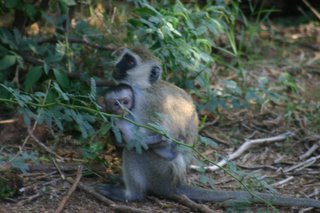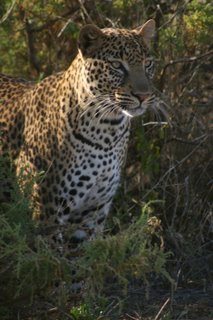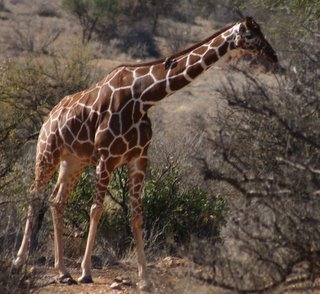Samburu




Another whirlwind trip to Nairobi, just long enough to fill up on Western food and movies, wash a few clothes, scrub the dirt out of our ears and put some deep conditioner on our heads before we were off again. We ate a huge breakfast and were lucky we did, as we didn’t stop until almost 2 p.m. for lunch.
The next safari was one few tourists do, a loop up north to Lake Turkana, a sliver of a salty water up near the Ethiopian border. I had seen the desert around Turkana featured in the Constant Gardener and the colours of the surrounding desert were fascinating, full of blacks and whites and ochre reds. We had read in the guidebooks that Turkana was full of bandits and robbers and even the tour company warned that we might pick up a police escort at some points. All I could think was, cool. We locked away our credit cards and passports and headed for what was advertised as the “worst road in Africa,” a dubious and highly competitive category if there ever was one.
We drove through coffee plantations and terraced tea farms, the red earth competing with the green of mango trees, up and up into even more fertile farming land, where irrigation tracts, plastic greenhouses and high barbed wire fences kept peas and peppers and potatoes safe from hungry cattle and marauding baboons. Mount Kenya loomed over it all, its snow-peaked caps peeking out occasionally amongst the clouds.
We pulled into Isiolo, where Daniel, our driver, assured us that the road ended and within a few days we’d be begging for a helicopter out. Isiolo was like a classic African town, stuffed with people, vibrant with markets. Kids peered out from all corners, women were covered head to toe in scarves, men zipped around on bicycles and motorbikes. We got to a security checkpoint and the women leaned in to sell bracelets, dolls, belts. When we stopped to buy charcoal, the women were wearing hundreds of loops of thick beads, enough that the necklaces came out like a cowl. Their earlobes were mutilated and filled with silver and they seemed to find Emily fascinating.
It was not far from Isiolo that we first noticed the women carrying jerry cans strapped around their foreheads. It seemed that the road was full of women in search of water and Daniel told us that the short rains that usually come to Kenya in November and December had not come at all. It hadn’t rained since June and this was about the fifth year in a row where the rains had come short if they’d come at all. The whole north was desperate for water, he said. “I don’t know, maybe God is mad at Kenya,” he said.
We inched closer and closer to Samburu park, passing over dried up river beds, on a road that was more washboard than anything else, our teeth bouncing. The Samburu homes were unlike anything we’d seen. The Masai, with their hundreds of cattle and sheep, are hugely rich by comparison, even if they live rather simply. The Samburu live in mud huts as well, but ones covered by bits of plastic, newsprint, corrugated steel, discarded cardboard, posterboard, whatever they can find. It was like seeing bundles of rags on the horizon and realizing that people actually lived inside.
The women walked in their finery, their shoulders weighed down with beads and their ears stretched with silver. The men were similarly dressed, with loops of beads crisscrossing their chests, daggers at their sides, beads looped around their wrist as far up as their elbows. They wore headdresses and carried sticks or spears.
We pulled into the park then drove slowly as the light faded toward our campsite, which we had been told was a lot rougher than the Masai Mara camp. We saw a gerenuk gazelle, with its skinny neck stretched like a giraffe and its huge ears tuned to the sounds around it. Dikdiks darted to and fro and we saw some Grevy’s zebras, with their delicate stripes and long faces. Then we came across a lion, just walking down the road. Monique, the Dutch woman who was with us, nearly jumped out of her skin. She hadn’t expected the animals to be so close, I suppose, and it was a bit unnerving to just see this big hulk of a cat go sauntering by.
The camp was just that, a semi-circle of tents with a fire pit in the middle, pit latrines off to the side and a shower wrapped around a tree down near the river. We were inside the park, so an escort to the bathroom was definitely in order. We sat down to a feast, then headed off to our tents, where the sounds of the animals rustling woke me a few times.
In the morning, we ate some toast and watched the bird life, including hornbilled Zazu type birds, who chased the weaver birds and their puffy blue cousins. The quails screamed from the bushes. We got in the car and drove over terrain that seemed rocky and barren when compared to the dry grass of the Masai Mara. It wasn’t long before we came on two young male lions on the prowl. We followed them to a puddle near the dried up river and watched them for a while, noticing the leopard-like spots on their bellies and the way they seemed to play with each other. We drove further and found some more zebras, some red elephants, smaller and wrinklier than their Masai counterparts, and finally upon some reticulated giraffes, whose geometric brown patches give them their name. We had some lunch, then a siesta and my parents decided to go for a walk down to the river, where they came across some giraffe and a couple camels who were hobbled and closely followed by a small boy.
We saw puppet monkeys, who carried their alien-esque babies slung over their backs. I was initially fascinated, but then they became a regular appearance at our campsite, edging closer and closer to the food and swinging into the trees whenever the cook or askaris thought they’d come close enough.
We also experienced our first safari rage, when we came across a leopard nestled in a bush near one of the paths. The vans piled up, creating a jam and as the minutes ticked by without movement, we started to get a bit restless about getting closer. (We were turning into “those” safari clients.)
Our nights were a cacophony of animal noises. One night we could hear what sounded like dogs barking, but was probably baboons. Another night we woke to the sound of snarling, the kind of low-in-the-throat warning sound of a lion and listened to what we thought was a big feast of two or three big cats about three feet from our tent. There was the screaming of the baboons and the barking of something else. Even though both Emily and I were awake – we were both holding our breath, thinking that the lions were eating right outside and neither of us wanted to attract any unwanted attention by making a sound or movement. In the morning we exclaimed over the drama that had gone on right outside the tents and Mom and Monique both said they’d slept right through it!

0 Comments:
Post a Comment
<< Home